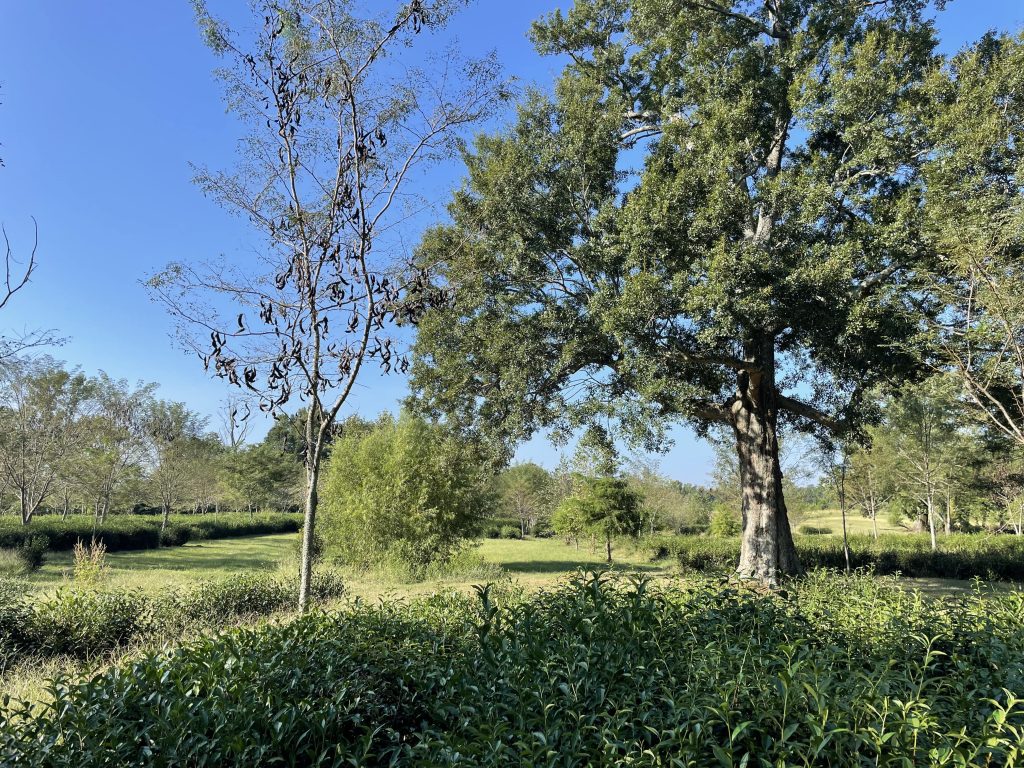Prefer podcasting? Check out Episode 2: Sustainable Tea and How To Find It of The Hideaway Tea Pod.
Whether Here or There…
Sustainable tea can be found around the world, although depending on where you look, it might not always be labeled that way. Indeed, even without an organic certification, knowledgeable artisans and farmers simply know how to grow tea in a way that respects their environment. Not only do their honored efforts benefit the surrounding ecosystem and our planet, but they also happen to produce the best tasting teas for generations. How and where does all this happen? We’re diving deep into the sciences of sustainable agriculture and biodiversity to find out.
Sustainable Agriculture
Sustainability alone is multi-faceted and can get quite complex, however in tackling the mountainous mystery of sustainable agriculture, let’s start simple. Broadly speaking, when referring to sustainable agriculture, I mean “farming which enhances life quality for all.” I’m also a fan of the US Department of Agriculture’s more expansive definition [1] –
The term ”sustainable agriculture” (U.S. Code Title 7, Section 3103) means an integrated system of plant and animal production practices having a site-specific application that will over the long-term:
- Satisfy human food and fiber needs.
- Enhance environmental quality and the natural resource based upon which the agriculture economy depends.
- Make the most efficient use of nonrenewable resources and on-farm resources and integrate, where appropriate, natural biological cycles and controls.
- Sustain the economic viability of farm operations.
- Enhance the quality of life for farmers and society as a whole.
Having this kind of vision is already a win, however accomplishing these goals can prove quite challenging. Even the best of farmers may not abide by every existing eco-friendly practice due to limited financial capacity or scarce labor – and that’s why it’s complicated. Still, of all that can be accomplished, sustainable practices on the field include –
Environment Protection
- Soil health plays a critical role in minimizing a farm’s impact on its surrounding ecosystem. Incorporated biodiversity (more on this later) and limited tilling or no-tilling strengthen soil structure and reduce erosion, protecting ecosystems from natural disasters like landslides or floods.
- When faced with a large and hungry population, a farmer must strategically balance crop yield, profit, and environmental impact – quite the formidable feat. In this way, farmers must be mindful when using fertilizers and pesticides, minimizing the potential for substance run-off in nearby streams and ensuring that excessive pesticide residue does not make its way into the food chain.
- Farmers must also weigh the benefits and environmental costs of maintaining acres of crops with heavy, gas-powered machinery. Great steps towards reducing carbon emissions include using biofuels and solar or electric-powered machines.
Resource Management
- Land itself is a finite resource. Data show that approximately 38% of all available land on Earth is being used solely for agriculture [3]. Stewarding land means resisting deforestation (via expansion) and ensuring that there is enough land for food production as well as city infrastructure, homes, wildlife habitats, and forestry for generations to come.
- According to the UNESCO (United Nations Educational, Scientific, and Cultural Organization), to date agriculture consumes a staggering 70% of all global freshwater withdrawals, and global demand has been increasing by roughly 1% since the 1980s [2]. The use of modern irrigation systems and proper water management practices, including conservation tillage and irrigation scheduling, can not only conserve water as a global resource and prevent water scarcity but also save a farmer some decent cash.
Now that we know what sustainable agriculture looks like practically, we’re equipped to sensibly approach the complexities of the hottest topic of farming – the great organic vs. non-organic debate (you knew this was bound to come up).
The ‘Organic’ Conundrum
By definition, organic farming excludes the use of synthetic substances, which initially sounds simple and honestly healthy. However, one might be surprised to learn how polarizing the topic of organic farming has become. Instead of pitting organic and conventional (non-organic) farming against one another as if there needs to be a winner, let’s take a step back to review agriculture more holistically.
Primary nutrients necessary for a plant’s growth include nitrogen, phosphorus, and potassium (or popularly abbreviated as NPK). Where these nutrients come from hardly matters to a plant so long as it gets them. Where these nutrients are lacking naturally, a farmer will use some form of fertilizer as a supplement to bolster crop growth.
Along these lines, in order to most effectively protect one’s growing field, a farmer will also use some form of pesticide, a man-made product designed to deter and/or kill hungry pests. No matter their sources, all pesticides are toxic.
Regarding organic and conventional methods, rather than immediately hashing out their differences (as we are more often accustomed to), let us notice how alike their fruits are (literally!). Studies show mixed results when comparing the nutritional differences (if any) between organically grown and conventionally grown produce. Many researchers conclude similarly –
“Pesticide excretion studies have consistently shown a reduction in urinary pesticide metabolites with an organic diet; however, there is insufficient evidence to show translation into clinically relevant and meaningful health outcomes. There is a need for studies to move beyond simply measuring the reduction in pesticide exposure with organic food, to investigating measurable health benefits.” [4]
Disregarding labels, each farm is unique and strategizes farming practices based on crop, financial capacity, available labor, regional conditions, and more, implementing conventional and/or organic practices to maximize yield. Both synthetic and organic over-fertilization can cause fertilizer burn, harm nearby aquatic life, deplete organic matter in soil, and even cause excess top growth at the expense of a crop’s strong root system. In the same way, overuse of any pesticide can be detrimental to human health and deathly to the broader food chain.
So what’s the answer? Do I buy organic teas or non-organic teas?
It’s really up to you based on your preferences. Conventional and organic crops are simply grown differently. If you really want to know which tea is more eco-friendly, the best way to find out would be to talk to its farmer.
Why Is Biodiversity Important?
Arguably, one of the most powerful influences on sustainable crop yield and one’s environment is biodiversity. This is observed across the board, even in tea production. By incorporating biodiversity into a field, the characteristics of various crops, herbage, and even wildlife are essentially combined into a functional ecosystem (ie. permaculture), strengthening an overall land’s disease and climate resilience, natural pest control, and soil structure. This, in turn, reduces fertilizer and pesticide use which would otherwise be necessary. Biodiversity can be incorporated through…
- Cover crops – grasses, legumes, or other green plants which are grown to literally ‘cover’ a land. Cover crops enrich a farm’s soil with nutrients, suppress weeds, maintain soil structure, and increase water infiltration.
- Polyculture farming – the sustainable agriculture technique of growing multiple crops or animals together in the same place at the same time
- Crop rotation – the planting of different crops sequentially on the same plot of land
- Local plants and animals – the plants and animals that were already there contribute to a farm’s biodiversity.
Meanwhile, a monoculture, though optimized (ie. simplified) for productivity and efficiency, is more vulnerable to an outbreak of a single type of pest or disease. Monocultures can upset a soil’s nutritional balance by having too many of only one crop and one type of root system in a region. Long-term monocultures trigger a massive chain reaction –
- Specific nutrients in a soil are depleted (and replaced by heavy use of fertilizers), gradually causing the variety of bacteria and microorganisms needed for soil fertility to decrease.
- Water retention is also impacted as only one type of root system may not be sufficient to maintain soil structure.
- Local pollinators “find themselves facing a homogeneous food territory and suffer from deficiencies due to the poor diversity of their diet” [5].
Eventually, a region is stripped of life.
Needless to say, biodiverse farms and fields are extremely valuable as they are essentially fountains of life. Maintaining biodiversity and embracing agroecology is certainly the way to go despite their many challenges. Polycultures can require completely new sets of skills, specialized knowledge, additional resources, new machinery, and more, all of which can be costly in terms of money and time.

So Now What?
By now, you might be feeling as if you’ve been slapped with a textbook. You might also wonder how in any way this relates to tea.
Now that you are so much more well-versed in agriculture than you ever intended to be, you’re equipped with the knowledge to find sustainable tea (amongst other foods) around the world. When discovering new teas, dare to ask…
- Where and how was the tea grown? Are there signs of biodiversity and does anything else (greenery, insects, animals) live on the tea farm?
- How was the tea harvested? By hand or by gas-powered machine? Or perhaps by both?
- What substances if any were applied onto the tea plants?
- Pro-tip – unless already weakened or diseased, tea plants typically do not need pesticides as their caffeine content naturally deter pests
- Might purchasing these tea leaves be a means of supporting a local or distant community?
As we’ve come to know, unfortunately the full story of any food is hardly told. The journey that tea leaves take before finally landing in our cups is – to put it lightly – long. Nevertheless, giving their sources a bit more thought can go a long way, benefiting our own awareness and as well as our greater supply chain by essentially increasing the demand for more environmentally responsible farms.
Final Reflections
I had a thought. In some ways, the lessons we glean from the earth itself are quite profound.
Today, we learned that biodiverse farms supply life to plants, animals, and humans alike – literally, diversity supplies life. On the other hand, it can be our human habit to simplify and optimize, to remove complicatedness or variety for the sake of efficiency or profit, for security or comfort, or even out of fear of the unknown. What would it look like to allow a bit more complexity into our lives as a means of slowing down? What could it look like outside our well-constructed bubbles of understanding? Perhaps embracing those who are different from us, as if we are the elaborate garden, is exactly what we need to thrive.
Perhaps a little mess is a good thing.
References
- U.S. Department of Agriculture (n.d.). Sustainable Agriculture | National Agricultural Library. National Agricultural Library. Retrieved 22 August. 2024, from https://nal.usda.gov/farms-and-agricultural-production-systems/sustainable-agriculture.
- UNESCO. (2024, February 26). Statistics. Unesco. Retrieved 22 August. 2024, from https://unesco.org/reports/wwdr/en/2024/s#:~:text=Worldwide%2C%20agriculture%20accounts%20for%20roughly,freshwater%20withdrawn%20for%20domestic%20purposes.
- Anderson, S. (2023, January 17). Cattle and Land Use: The Differences between Arable Land and Marginal Land and How Cattle Use Each. CLEAR Center. Retrieved 22 August. 2024, from https://clear.ucdavis.edu/explainers/cattle-and-land-use-differences-between-arable-land-and-marginal-land-and-how-cattle-use#:~:text=Land%20is%20a%20Finite%20Source,38%25%20is%20used%20for%20agriculture.
- Vigar, V., Myers, S., Oliver, C., Arellano J., Robinson, S., & Leifert, C. (2020). A Systematic Review of Organic Versus Conventional Food Consumption: Is There a Measurable Benefit on Human Health?. PMC. 12(1). 7. https://doi.org/10.3390/nu12010007.
- EOS Data Analytics. (2020). Monoculture Farming In Agriculture Industry. EOS Data Analytics. Retrieved 22 August. 2024, from https://eos.com/blog/monoculture-farming/#:~:text=Agricultural%20monoculture%20upsets%20the%20natural,maintain%20fertility%20of%20the%20soil.



